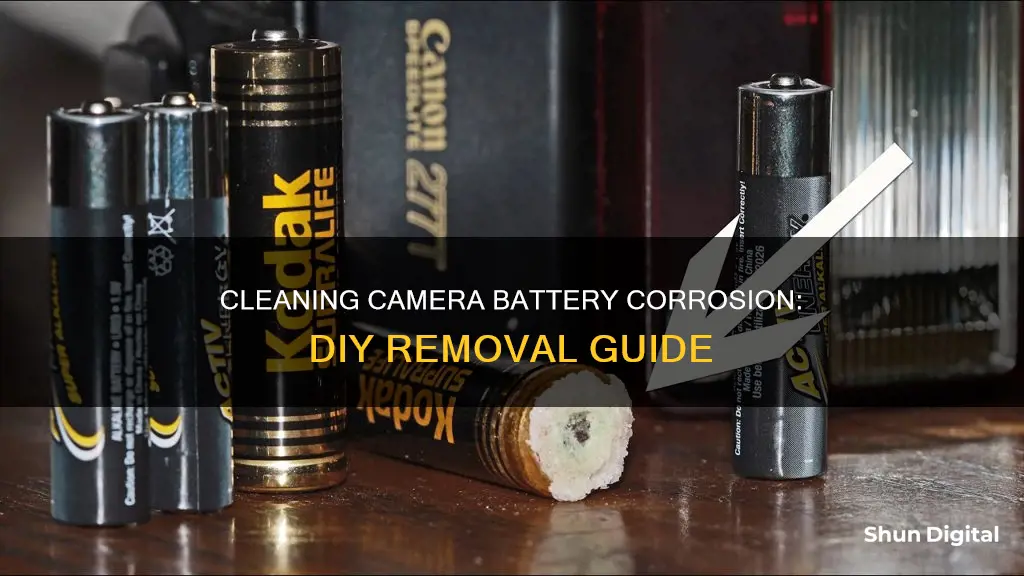
If you've left your camera unused for a long time, you may find that the batteries have leaked, causing a white, crusty residue known as battery corrosion. This can be safely removed, and there are several methods you can try. One common method is to use white vinegar or lemon juice on a cotton swab to clean the affected areas. You can also try a mixture of water and baking soda, or a stronger solution such as Lime-Away. When cleaning, make sure to wear gloves and ensure the camera is upright to prevent any liquid from entering the device.
| Characteristics | Values |
|---|---|
| Tools | Isopropyl Alcohol, Q-Tips or Cotton Swabs, Rubber Gloves, Baking Soda, White Vinegar, Clean Towel, Flashlight, Fine-Grit Sandpaper, Toothbrush, Foam Q-Tips |
| Steps | 1. Open the battery door and identify corrosion using a flashlight. 2. Wipe away corrosion debris with a dry cotton swab. 3. Apply isopropyl alcohol, white vinegar, or a mixture of water and baking soda to a cotton swab and clean the affected areas. 4. For tougher corrosion, use fine-grit sandpaper or a toothbrush. 5. Clean off any remaining residue with a dry cotton swab or towel. 6. Let the camera dry before putting in new batteries. |
What You'll Learn

Wear gloves and a mask to protect yourself from the acid
When removing battery corrosion from a camera, it is important to wear gloves and a mask to protect yourself from the acid. Battery corrosion is caused by the release of hydrogen gas from the sulfuric acid inside the battery as it runs. This gas then mixes with the air, moisture, and salt, resulting in a corrosive chemical reaction. The corrosive substance is highly toxic and can cause serious eye damage and skin and respiratory irritation.
The gloves you wear should be heavy-duty, such as rubber or latex gloves, to protect your skin from the corrosive material. A mask or face covering is also important to protect your respiratory system and prevent inhalation of toxic fumes. It is also recommended to wear safety glasses or goggles to shield your eyes from potential splashes or dust.
The gloves will act as a protective barrier between your skin and the corrosive acid. They will prevent the acid from coming into direct contact with your skin, reducing the risk of irritation or chemical burns. By wearing gloves, you can safely handle the corroded batteries and cleaning materials without exposing your skin to harmful substances.
Wearing a mask is crucial when working with corrosive materials to safeguard your respiratory health. The mask will filter the air you breathe, preventing the inhalation of toxic fumes and dust particles released during the cleaning process. It is important to ensure a proper fit for the mask, creating a seal around your mouth and nose to maximize protection.
TCL 4K Roku TV: Camera and Microphone Features Explored
You may want to see also

Remove the batteries
Removing the batteries from your camera is an important first step in cleaning corrosion from your device. It is also a good preventative measure to avoid corrosion in the first place.
Before removing the batteries, make sure you are wearing gloves to protect your skin from the corrosive acid. You should also be careful not to get any acid on your skin or in your eyes. It is also recommended to work on a clean surface and to have a clean towel or cloth nearby to hand.
Once you have removed the batteries, you can begin to assess the level of corrosion in the battery compartment. Using a flashlight, identify where exactly the corrosion is and how much there is. It usually looks like rust.
After you have identified the corrosion, you can then begin to clean it. However, the process of cleaning the corrosion from the battery compartment is not covered in this paragraph request.
Smart TV Cameras: Privacy and Security Concerns
You may want to see also

Use a cotton swab to wipe away debris
To remove battery corrosion from your camera, you'll need to use a cotton swab to wipe away debris. This is a delicate process, so it's important to be careful and thorough. Here's a step-by-step guide:
Before you begin, ensure you have the right equipment. You'll need cotton swabs, also known as Q-tips, gloves, a clean towel, and a cleaning solution such as isopropyl alcohol, vinegar, or lemon juice. It is also recommended to wear a mask and rubber gloves to protect yourself from the dried-up battery acid.
Start by opening the battery door of your camera. Use a flashlight to identify the areas affected by corrosion. Corrosion usually resembles rust. Apply your chosen cleaning solution to a cotton swab. You can dip the swab into the liquid or apply a few drops, ensuring it is saturated. Gently wipe and clean the affected areas. Be thorough and clean as much of the corrosion as possible.
If you're using isopropyl alcohol, you may need to apply a bit of baking soda to the areas after removing the corrosion. Then, take a new, clean cotton swab and apply a small amount of vinegar to it. Gently drip the vinegar onto the areas with baking soda. Be cautious not to use too much liquid, as it could damage the internal components of your camera.
Once you've finished applying the cleaning solution, use a dry cotton swab to remove any remaining moisture from the battery compartment. It's important to ensure the area is dry before proceeding. Leave the battery compartment open and allow it to air dry completely. You can gently pat it down with a clean towel to absorb any excess liquid.
After the cleaning process, it's a good idea to let the camera dry for a few hours. This ensures that any remaining liquid evaporates. If you're unsatisfied with the results or believe there is still corrosion, you can repeat the entire process. Remember to work carefully and gently throughout the entire process to avoid damaging your camera's internal components.
Setting Up a Camera Live Feed to Your TV
You may want to see also

Apply a small amount of vinegar or lemon juice to a cotton swab and clean the device
To remove battery corrosion from a camera, you'll need to protect yourself and your workspace. Spread newspaper over your work surface and put on protective gear: gloves and safety glasses.
Before you start cleaning, remove the corroded batteries from the battery compartment and dispose of them. Check with your local sanitation department to find out how to dispose of batteries properly.
Now, it's time to clean the corrosion from the battery compartment and contacts. Potassium hydroxide, the substance that leaks from alkaline batteries, is a base, so it's best neutralized with an acid such as vinegar or lemon juice.
Using a cotton swab, apply a small amount of vinegar or lemon juice to the corroded area. Be careful not to oversaturate the swab, so you don't get liquid inside the electrical components of your camera. It should be damp but not dripping wet. You can always squeeze the swab to remove any excess liquid.
Gently rub the swab over the corroded area, being careful not to press too hard. You want to avoid pushing the corrosion further into the device or spreading it to other areas. Work in small, controlled motions, and be patient as you may need to apply the vinegar or lemon juice a few times to fully remove the corrosion.
After applying the vinegar or lemon juice, wait a minute or two for it to take effect. You should see the crystalline corrosion start to dissolve and disintegrate. If necessary, use a small brush or toothbrush to gently scrub away any remaining corrosion. Be careful not to damage the contacts or surrounding areas.
Once you've removed the corrosion, use a clean, dry microfiber cloth to wipe down the area. Ensure you remove any residue from the vinegar or lemon juice, as well as any excess moisture. You can also use compressed gas designed for cleaning electronics to remove any stubborn fibres or residue.
Let the device dry completely before installing fresh batteries and powering it up.
Unlocking the IR Camera's Vision on Your Switch
You may want to see also

Let the camera dry before putting in new batteries
It is important to let your camera dry before putting in new batteries. This is because any residual moisture left in the camera can cause further corrosion and damage to the internal circuitry. By ensuring that the camera is completely dry, you can help prevent future corrosion and increase the longevity of your device.
Additionally, if you are using a cleaning agent such as vinegar or isopropyl alcohol to remove the corrosion, it is crucial to give the camera sufficient time to dry. These substances are often diluted with water, which can leave moisture in the camera's battery compartment. Allowing the camera to dry will ensure that any water residue evaporates, reducing the risk of future corrosion.
The drying time will vary depending on the climate and humidity levels in your area. In regions with high humidity, it is advisable to give the camera ample time to dry, as moisture can take longer to evaporate in such conditions. You can speed up the drying process by placing the camera in a well-ventilated area or using a hair dryer on a low setting to gently blow air into the battery compartment. However, always ensure that the camera is completely dry before inserting new batteries.
Moreover, it is worth noting that some cameras may have specific instructions or recommendations regarding drying and battery storage. For instance, the Canon EOS 1000D manual advises removing the battery and storing the camera in a cool, dry, and well-ventilated location if it will not be used for an extended period. Therefore, it is always a good idea to refer to your camera's user manual for any manufacturer-specific guidelines.
Troubleshooting Alexa's Camera Visibility Issues
You may want to see also
Frequently asked questions
It is recommended to wear gloves and a mask when handling battery corrosion, as it involves dried-up battery acid which can be caustic.
You can use cotton swabs/Q-tips, a soft cloth, high-strength isopropyl alcohol, and white vinegar or lemon juice.
First, open the battery door and use a flashlight to identify areas of corrosion. Next, gently wipe away any corrosion debris with a cotton swab. Then, apply a small amount of vinegar or lemon juice to a new cotton swab and clean the affected areas. Finally, use a dry cotton swab to remove any remaining moisture and leave the battery compartment open to dry completely before inserting new batteries.
The best way to prevent corrosion is to remove batteries from devices that you do not plan to use for an extended period. Additionally, store your camera in a dry and cool place, and avoid using expired batteries.







